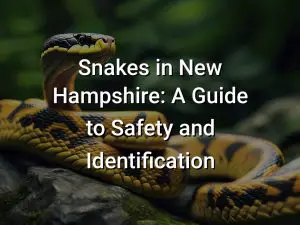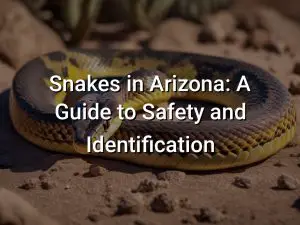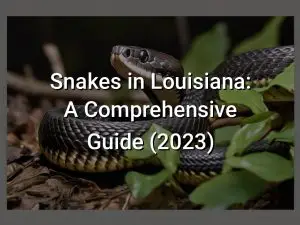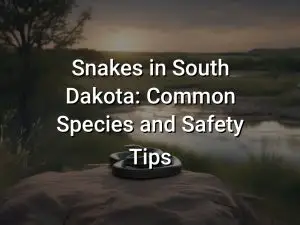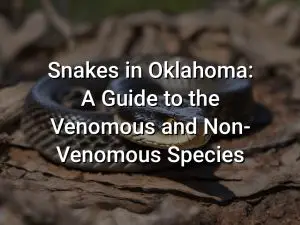Snakes in Pennsylvania: Species, Safety, and What to Do
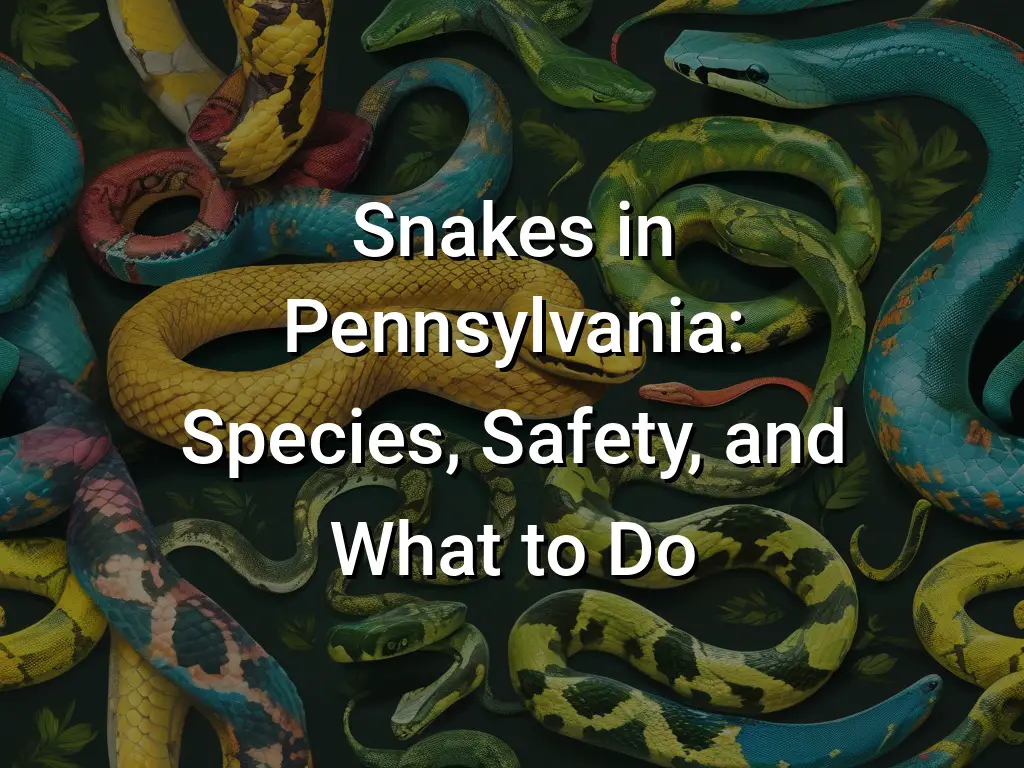
Pennsylvania may not be the first place that comes to mind when you think of snakes, but the state is actually home to a diverse range of snake species. Whether you have a fascination with these slithering creatures or just want to know what to do if you encounter one, we’ve got you covered. From the common snake species found in Pennsylvania to safety tips and conservation efforts, this article is your guide to snakes in the Keystone State.
Discover the fascinating world of snakes in Pennsylvania and learn how to safely coexist with them. Whether you’re interested in identifying different species, looking for advice on what to do if you come across a snake, or want to explore the conservation efforts in place to protect these reptiles, this article has everything you need to know.
Quick Links
Introduction
Snakes are a fascinating and diverse group of reptiles that can be found in various habitats around the world, including Pennsylvania. While some people may have a fear or aversion towards snakes, it is important to remember that they play an important role in our ecosystem.
In this article, we will explore the common snake species found in Pennsylvania, provide safety tips for encountering snakes, discuss what to do if you come across a snake, and provide information on snakebite treatment. We will also explore the benefits of snakes in Pennsylvania, conservation efforts to protect them, and educational resources available for learning more about these reptiles.
By understanding and respecting snakes, we can coexist with them and appreciate their place in our natural environment.
Common Snake Species in Pennsylvania
Pennsylvania is home to a variety of snake species, some of which are harmless and others that are venomous. Here are some of the common snake species you may encounter in the state:
- Eastern Garter Snake: This non-venomous snake is one of the most commonly encountered species in Pennsylvania. It has a long, slender body with three distinct yellow stripes running down its back.
- Eastern Milk Snake: Another non-venomous species, the Eastern Milk Snake is known for its vibrant colors and blotchy pattern. It can be found in a variety of habitats, including forests, fields, and farmland.
- Northern Water Snake: Often mistaken for a venomous snake, the Northern Water Snake is actually harmless. It is commonly found near bodies of water and has a dark brown or black body with reddish-brown blotches.
- Copperhead: This venomous snake is one of two venomous species found in Pennsylvania. It has a distinctive copper-colored head and a patterned body that helps it blend in with its surroundings.
- Timber Rattlesnake: The Timber Rattlesnake is the other venomous snake species found in Pennsylvania. It is a large snake with a rattling tail, which it uses as a warning signal. Timber Rattlesnakes are found in rocky areas and forests.
While encounters with snakes can be unnerving, it’s important to remember that most snakes in Pennsylvania are harmless and play an important role in the ecosystem. It’s always best to give snakes their space and observe them from a safe distance.
Snake Safety Tips
Snakes are a common sight in Pennsylvania, and while most species are harmless, it’s important to know how to coexist with them safely. Here are some snake safety tips to keep in mind:
- Stay calm and avoid sudden movements if you encounter a snake. Most snakes will not attack unless they feel threatened.
- Give snakes their space and do not approach or try to handle them. Respect their natural habitat and keep a safe distance.
- Wear appropriate footwear, such as closed-toe shoes or boots, when hiking or walking in areas where snakes may be present.
- Be cautious when stepping over logs, rocks, or other potential snake hiding spots. Look before you step to avoid accidentally stepping on a snake.
- Avoid tall grass and dense vegetation where snakes may hide. Stick to designated trails whenever possible.
- Keep your yard clean and free of debris, as snakes may seek shelter in areas with tall grass, piles of leaves, or woodpiles.
- Make your property less attractive to snakes by eliminating potential food sources, such as rodents and insects.
- If you have a snake in your home or immediate vicinity and feel unsure about handling it, contact a professional snake removal service.
Remember, most snakes play a vital role in the ecosystem by controlling rodent populations and should be left undisturbed. By practicing snake safety and respecting their habitats, we can peacefully coexist with these fascinating creatures in Pennsylvania.
What to Do If You Encounter a Snake
Encountering a snake can be a startling experience, but it’s important to stay calm and follow these guidelines:
- Keep Your Distance: Snakes prefer to avoid humans and will generally retreat if given the opportunity. Back away slowly and give the snake plenty of space.
- Stay Calm: Avoid sudden movements or loud noises that may startle the snake. Move slowly and deliberately.
- Identify the Snake: If it is safe to do so, try to identify the species of snake. This information can be helpful for determining if the snake is venomous and for medical professionals in case of a snakebite.
- Do Not Touch or Provoke the Snake: Snakes are defensive creatures and may bite if they feel threatened. Avoid handling or provoking the snake in any way.
- Do Not Try to Kill the Snake: Killing snakes is unnecessary and can be dangerous. It is also illegal to kill certain protected snake species. Allow the snake to go about its business and find a safe place away from humans.
- Keep Pets and Children Away: If you encounter a snake in your yard, keep pets and children indoors until the snake has moved on or professional assistance has arrived.
- Call a Professional: If you are unsure about the snake or if it is in a location where it poses a risk, contact a professional wildlife removal service or your local animal control for assistance. They have the knowledge and equipment to safely handle and remove snakes.
Remember, most snakes in Pennsylvania are non-venomous and pose no threat to humans. It is best to admire them from a distance and allow them to fulfill their ecological roles as beneficial predators in the ecosystem.
Snakebite Treatment
If you or someone you know gets bitten by a snake, it is important to seek immediate medical attention. Snakebites can be dangerous and potentially life-threatening, so it is crucial to follow the proper treatment protocols. Here are some steps to take if you encounter a snakebite:
- Stay calm and try to identify the snake if possible. This can help medical professionals provide the appropriate treatment.
- Keep the affected person still and immobilize the bitten area. This can help slow down the spread of venom.
- Remove any constrictive items, such as jewelry or tight clothing, near the bite area. Swelling can occur, so it is important to prevent circulation from being cut off.
- Do not try to suck out the venom or make incisions around the bite. These methods are not effective and can cause more harm.
- Call emergency services or go to the nearest hospital as soon as possible. The medical professionals will administer the appropriate antivenom and provide further treatment.
- While waiting for medical help, keep the person calm and still. Movement can increase the spread of venom.
It is important to remember that not all snakes are venomous, and most snakebites in Pennsylvania are from non-venomous species. However, it is always best to err on the side of caution and seek medical attention in case of a snakebite. Prompt and proper treatment can greatly increase the chances of a successful recovery.
Benefits of Snakes in Pennsylvania
Snakes play an important role in the ecosystem of Pennsylvania and offer several benefits:
- Controlling rodent populations: Snakes are natural predators of rodents, which can be pests in urban and agricultural areas. By keeping rodent populations in check, snakes help maintain a balance in the ecosystem.
- Biodiversity: Snakes are a vital part of Pennsylvania’s biodiversity. The presence of different snake species indicates a healthy and diverse ecosystem. Each snake species has its own ecological niche and contributes to the overall balance of the ecosystem.
- Pollination: Some snake species, such as the Eastern Indigo Snake, are known to play a role in pollination. They may feed on flowering plants and inadvertently transfer pollen from one flower to another, assisting in plant reproduction.
- Indicator species: Snakes can act as indicators of environmental health. Their presence or absence can indicate the overall well-being of an ecosystem. Monitoring snake populations can help researchers understand the ecological health of Pennsylvania’s habitats.
- Educational value: Snakes serve as educational tools, helping people learn about the importance of wildlife conservation and the role of snakes in the ecosystem. They can inspire appreciation and understanding of the natural world.
Although snakes may evoke fear and misconceptions, it is important to recognize the benefits they provide to Pennsylvania’s environment. By understanding their ecological value, we can foster a greater appreciation for these misunderstood creatures.
Conservation Efforts
Conservation efforts are crucial for the protection and preservation of snakes in Pennsylvania. Snakes play a vital role in maintaining the balance of ecosystems, and their conservation is essential for maintaining biodiversity and a healthy environment.
Several organizations and agencies in Pennsylvania are working towards the conservation of snakes and their habitats. The Pennsylvania Fish and Boat Commission (PFBC), for example, has implemented various programs and initiatives aimed at promoting snake conservation. These include habitat restoration projects, public education and outreach programs, and research and monitoring efforts.
One of the primary focuses of conservation efforts is protecting and preserving important snake habitats. This includes safeguarding wetlands, forests, meadows, and other natural areas that provide essential resources for snakes, such as food, shelter, and breeding sites.
In addition to habitat conservation, efforts are also being made to reduce threats to snake populations. These threats include habitat loss and fragmentation, pollution, climate change, and illegal collection and trade. By addressing these threats and implementing measures to mitigate their impact, conservationists aim to ensure the long-term survival of snakes in Pennsylvania.
Public education and outreach programs are vital components of snake conservation efforts. These programs aim to raise awareness about the importance of snakes, dispel myths and misconceptions, and promote coexistence between snakes and humans. By educating the public, conservationists hope to foster a greater understanding and appreciation for these fascinating creatures.
If you are interested in supporting snake conservation in Pennsylvania, there are several ways to get involved. You can volunteer with local conservation organizations, participate in citizen science projects, and support legislation and policies that promote snake conservation. Additionally, you can contribute to snake conservation efforts by donating to organizations dedicated to protecting Pennsylvania’s snakes and their habitats.
By working together and implementing effective conservation strategies, we can ensure the continued presence of snakes in Pennsylvania and contribute to the overall health and balance of our ecosystems.
Educational Resources on Snakes
For individuals interested in learning more about snakes, there are various educational resources available. These resources offer valuable information about snake species, behavior, habitat, and conservation efforts. Here are some recommended educational resources on snakes:
- Field Guides: Field guides are comprehensive books that provide detailed information and photographs of different snake species. They help individuals identify snakes and learn about their unique characteristics. Some popular field guides for snakes include “A Field Guide to Reptiles and Amphibians” by Roger Conant and Joseph T. Collins, and “Snakes of the United States and Canada” by Carl H. Ernst and Evelyn M. Ernst.
- Online Databases: Online databases such as HerpMapper and iNaturalist allow users to contribute and access data on snake sightings and species distribution. These resources can be helpful for research, conservation, and citizen science initiatives.
- Herpetological Societies: Many states have herpetological societies or organizations dedicated to the study and conservation of reptiles and amphibians. These societies often offer educational resources, workshops, field trips, and opportunities to connect with experts and fellow enthusiasts.
- Nature Centers and Museums: Nature centers and museums often have exhibits and educational programs about snakes and other reptiles. These resources provide hands-on learning experiences, guided tours, and interactive displays.
- Online Videos and Webinars: Websites such as YouTube and webinars hosted by reptile experts or organizations offer informative videos and presentations on snakes. These resources can be a convenient way to learn about snake behavior, identification, and conservation from the comfort of your own home.
By taking advantage of these educational resources, individuals can deepen their understanding of snakes and enhance their appreciation for these fascinating creatures.
Conclusion
Snakes are a common and important part of Pennsylvania’s ecosystem, but it’s understandable to have concerns about encounters with them. By following snake safety tips and knowing what to do if you encounter a snake, you can navigate outdoor spaces with confidence and reduce the risk of snakebite.
In the event of a snakebite, seeking immediate medical attention is crucial. Remember, most snakes in Pennsylvania are non-venomous, but it’s always better to err on the side of caution and let a healthcare professional assess the situation.
Furthermore, it’s important to recognize the benefits of snakes in Pennsylvania’s environment. They play a significant role in controlling rodent populations and maintaining a balanced ecosystem. Conservation efforts focused on protecting snake habitats and educating the public about these fascinating creatures are crucial for environmental preservation.
So go out and enjoy Pennsylvania’s natural spaces, knowing how to safely coexist with snakes and appreciating their important role in the ecosystem.

